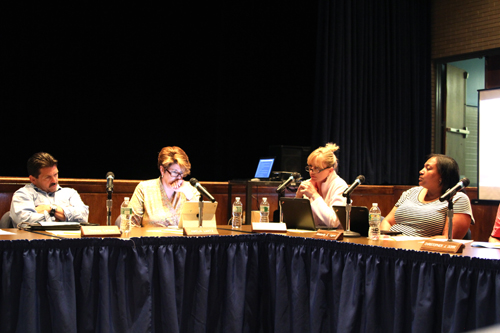Considering new boundaries, BOE OK’s study on elementary schools

The Riverhead school board unanimously approved a study Tuesday night to determine if the district should reconfigure its elementary school boundaries in the wake of concerns raised by local residents about the demographic makeup of the schools.
During the school board’s meeting Tuesday night, Superintendent Nancy Carney said the $9,000 contract with Western Suffolk BOCES includes analyzing Riverhead’s demographics, enrollment projections, bus routes and transportation costs.
Since the district covers about 100 square miles, Ms. Carney said one concern is to ensure students are traveling to school in the least amount of time possible — especially young children.
Although BOCES will provide the district with data, the superintendent said it will not make recommendations on changes to the current boundaries — known as catchment areas — for Riley, Phillips, Aquebogue, and Roanoke elementary schools. Redrawing the current lines is up to the school board and community, she said.
Ms. Carney said the district is facing “very challenging issues” with demographics and the study will help it make sure the “elementary schools are representative of the entire population.”
Previous studies failed to forecast “exploding” enrollment at Phillips and Roanoke, she said, as well as the decreasing population at Riley and Aquebogue.
Prior to voting on the BOCES contract, board member Christopher Dorr questioned if the district could conduct the study itself.
“The data is publicly available,” said Mr. Dorr, who works as a shared data coordinator at Nassau BOCES. “In the district, you do projections of enrollment every year based on previous year enrollments, so it should be available.
“I just don’t think we need to spend $9,000,” he said.
Ms. Carney — who gave a presentation about the district’s demographics at a recent school board meeting — described the BOCES study as “comprehensive” and said it will compile all of the data needed for the school board and community to make a decision on how to move forward.
School board president Ann Cotten-DeGrasse agreed and requested that the study include projections for rental properties, since prior reports failed to predict the influx of families renting within the last four years.
After Ms. Carney outlined the process, Mr. Dorr voted in favor of approving the contract, which passed by a 6-0 vote. Board vice president Greg Meyer was absent from the meeting.
If the school board and community are interested in moving forward with changing the elementary school lines after reviewing BOCES’s findings, Ms. Carney said they wouldn’t be redrawn for at least a couple of years.
In recent months, residents have been questioning at recent school board meetings why students living in Calverton Hills are required to enroll at Phillips in Riverside when Riley in Calverton is closer to them.
The issue sparked after an incident reported in a Feb. 27 News-Review cover story about two Riley Avenue students who brought a knife to school and plotted an attack on a fellow second-grader in November. The victim’s mother, who is black, said in the article she was concerned that race had played a role in permitting those students, who are white, to return to class just three months after the incident, despite a code of conduct that suggests a minimum one-year suspension for incidents involving a weapon.
About 61 percent of Phillips students are Hispanic, 19.5 percent are black and 15.9 percent are white, according to Ms. Carney’s May 13 presentation. Over at Riley, 72 percent of students are white, 17.3 percent are Hispanic and 5.5 percent are black.







